UNDERSTANDING YOUR DATA:THE ESSENTIALS OF EXPLORATORY DATA ANALYSIS.
Introduction
Based on the end goal you have about your data as a result of a machine learning model, development of visualizations and incorporation of user friendly applications, developing fluency in the data at the beginning of the project will bolster the final success.
Essentials of EDA
This is where we get to learn on how the necessity of data preprocessing is beneficial to data analysts.
Due to the vastness and various sources, today's data is more likely to be abnormal. The preprocessing of data has become the foundation stage in the field of data science since high quality data results in more robust models and predictions.
Exploratory data analysis is a data scientist's tool to see what data can expose outside the formal modelling or assumption testing task.
Data scientist must always perform EDA to ensure the reliable results and applicable to any effected outcomes and objectives. It also assists scientists and analysts in confirming that they are on the proper track to achieve the desired results.
Some of the examples of research questions that guide the study are:
1.Is there any significant effect of preprocessing of data
analysis approaches-- missing values, the aggregate of values, data filtering, outliers, variable transformation, and variable reduction - on accurate data analysis results?
2. At what significant level is preprocessing data analysis necessary in research studies?
Exploratory Data Analysis Metrics and Their Importance
1.Data Filtering
This is the practice of picking a smaller section of a dataset and using that subset for viewing or analysis. The full data set is kept, but only a subset of it is used for calculation; filtering is typically a temporary procedure. Discovering inaccurate, incorrect, or subpar observations from the study, extracting data for a specific interest group, or hunting for information for a specific period can all be summed up using filters. The data scientist must specify a rule or logic during filtering to extract cases for the study.
2.Data Aggregation
Data aggregation requires gathering unprocessed data into a single location and summing it up for analysis. Data aggregation increases the informational, practical, and usable value of data. The perspective of a technical user is often used to define the phrase. Data aggregation is the process of integrating unprocessed data from many databases or data sources into a centralized database in the instance of an analyst or engineer. The aggregate numbers are then created by combining the raw data. A sum or average is a straight forward illustration of an aggregate value. Aggregated data is used in the analysis, reporting, dashboarding, and other data products. Data aggregation can increase productivity, decision-making, and time to insight.
3.Missing Data
In data analytics, missing values are another name for missing
data. It occurs when specific variables or respondents are left out or skipped. Omissions can happen due to incorrect data entry, lost files, or broken technology. Missing data can intermittently result in model bias, depending on their type, which makes them problematic. Missing data implies that since data may have come from misleading sample at times, outcomes may only be generalizable within the study's parameters. To ensure consistency across the entire dataset, it is necessary to recode all missing values with labels of "N/A"(short for "not applicable").
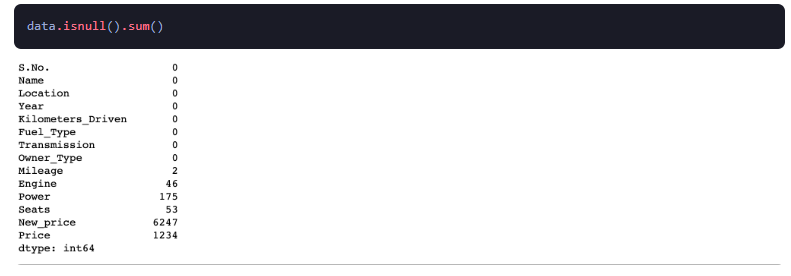
4.Data Transformation
Data are rescaled using a function or other mathematical
operation on each observation during a transformation. We
occasionally alter the data to make it easier to model when it
is very significantly skewed (either positively or negatively).
In other words, one should try a data transformation to suit the assumption of applying a parametric statistical test if
the variable(s) does not fit a normal distribution. The most popular data transformation is log (or natural log), which is frequently used when all of the observations are positive, and most of the data values cluster around zero concerning the more significant values in the data set.
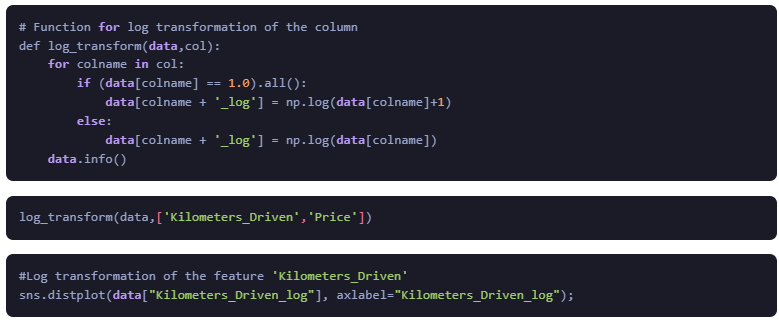
Diagram illustration
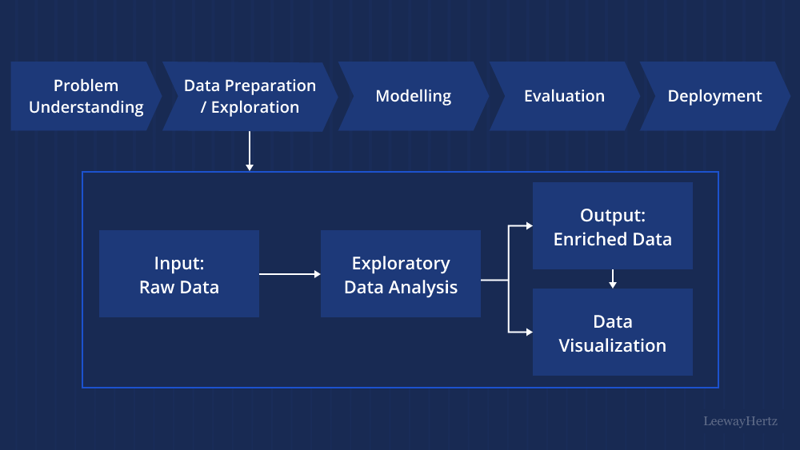
Visualization techniques in EDA
Visualization techniques play an essential role in EDA, enabling us to explore and understand complex data structures and relationships visually. Some common visualization techniques used in EDA are:
1.Histograms:
Histograms are graphical representations that show the distribution of numerical variables. They help understand the central tendency and spread of the data by visualizing the frequency distribution.

2.Boxplots: A boxplot is a graph showing the distribution of a numerical variable. This visualization technique helps identify any outliers and understand the spread of the data by visualizing its quartiles.
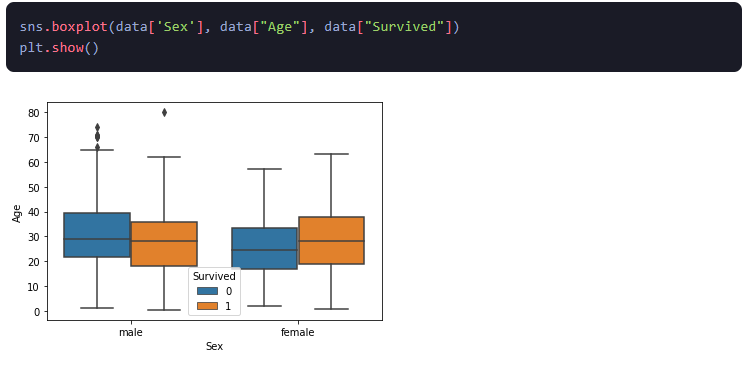
3.Heatmaps: They are graphical representations of data in which colors represent values. They are often used to display complex data sets, providing a quick and easy way to visualize patterns and trends in large amounts of data.

4.Bar charts: A bar chart is a graph that shows the distribution of a categorical variable. It is used to visualize the frequency distribution of the data, which helps to understand the relative frequency of each category.
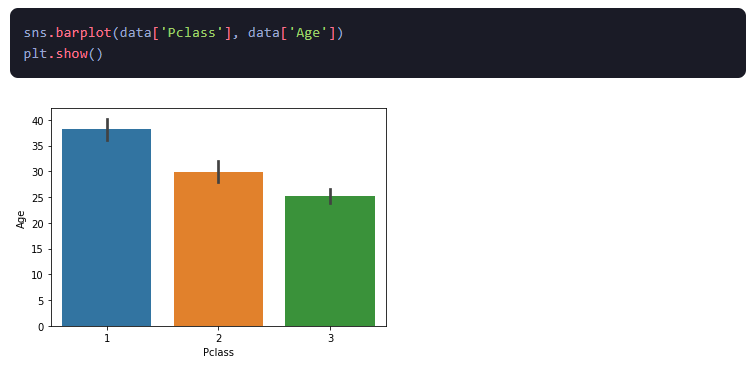
5.Line charts: A line chart is a graph that shows the trend of a numerical variable over time. It is used to visualize the changes in the data over time and to identify any patterns or trends.

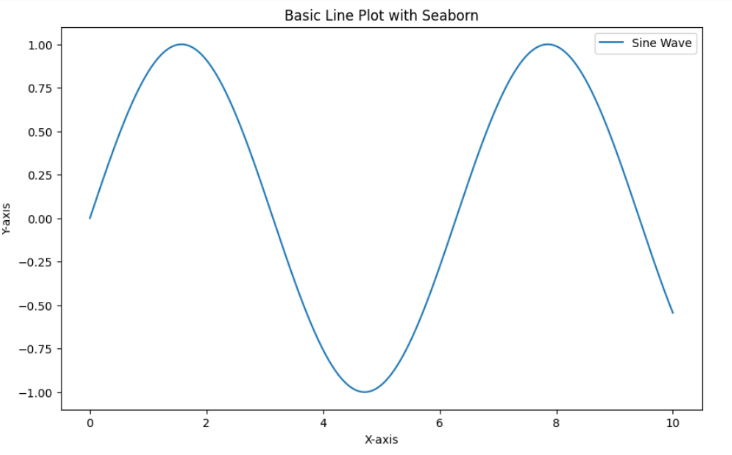
5.Pie charts: Pie charts are a graph that showcases the proportion of a categorical variable. It is used to visualize each category’s relative proportion and understand the data distribution.
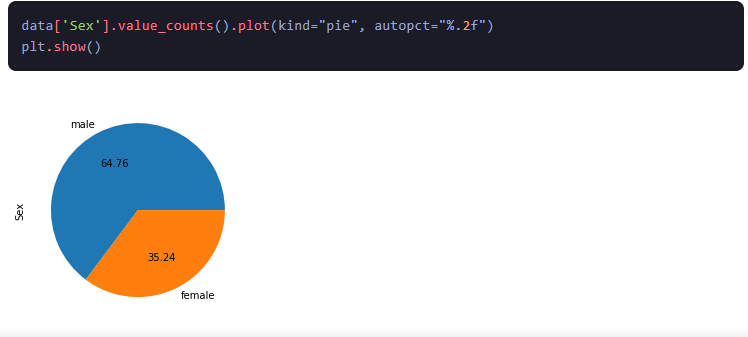
-
 How to extract elements from 2D array? Using another array's indexUsing NumPy Array as Indices for the 2nd Dimension of Another ArrayTo extract specific elements from a 2D array based on indices provided by a second ...Programming Posted on 2025-04-27
How to extract elements from 2D array? Using another array's indexUsing NumPy Array as Indices for the 2nd Dimension of Another ArrayTo extract specific elements from a 2D array based on indices provided by a second ...Programming Posted on 2025-04-27 -
 How Can I Maintain Custom JTable Cell Rendering After Cell Editing?Maintaining JTable Cell Rendering After Cell EditIn a JTable, implementing custom cell rendering and editing capabilities can enhance the user experie...Programming Posted on 2025-04-27
How Can I Maintain Custom JTable Cell Rendering After Cell Editing?Maintaining JTable Cell Rendering After Cell EditIn a JTable, implementing custom cell rendering and editing capabilities can enhance the user experie...Programming Posted on 2025-04-27 -
 Solve the \\"String value error\\" exception when MySQL inserts EmojiResolving Incorrect String Value Exception When Inserting EmojiWhen attempting to insert a string containing emoji characters into a MySQL database us...Programming Posted on 2025-04-27
Solve the \\"String value error\\" exception when MySQL inserts EmojiResolving Incorrect String Value Exception When Inserting EmojiWhen attempting to insert a string containing emoji characters into a MySQL database us...Programming Posted on 2025-04-27 -
 How do you extract a random element from an array in PHP?Random Selection from an ArrayIn PHP, obtaining a random item from an array can be accomplished with ease. Consider the following array:$items = [523,...Programming Posted on 2025-04-27
How do you extract a random element from an array in PHP?Random Selection from an ArrayIn PHP, obtaining a random item from an array can be accomplished with ease. Consider the following array:$items = [523,...Programming Posted on 2025-04-27 -
 Why Does Microsoft Visual C++ Fail to Correctly Implement Two-Phase Template Instantiation?The Mystery of "Broken" Two-Phase Template Instantiation in Microsoft Visual C Problem Statement:Users commonly express concerns that Micro...Programming Posted on 2025-04-27
Why Does Microsoft Visual C++ Fail to Correctly Implement Two-Phase Template Instantiation?The Mystery of "Broken" Two-Phase Template Instantiation in Microsoft Visual C Problem Statement:Users commonly express concerns that Micro...Programming Posted on 2025-04-27 -
 How does Android send POST data to PHP server?Sending POST Data in AndroidIntroductionThis article addresses the need to send POST data to a PHP script and display the result in an Android applica...Programming Posted on 2025-04-27
How does Android send POST data to PHP server?Sending POST Data in AndroidIntroductionThis article addresses the need to send POST data to a PHP script and display the result in an Android applica...Programming Posted on 2025-04-27 -
 How to Implement a Generic Hash Function for Tuples in Unordered Collections?Generic Hash Function for Tuples in Unordered CollectionsThe std::unordered_map and std::unordered_set containers provide efficient lookup and inserti...Programming Posted on 2025-04-26
How to Implement a Generic Hash Function for Tuples in Unordered Collections?Generic Hash Function for Tuples in Unordered CollectionsThe std::unordered_map and std::unordered_set containers provide efficient lookup and inserti...Programming Posted on 2025-04-26 -
 How to dynamically access global variables in JavaScript?Accessing Global Variables Dynamically by Name in JavaScriptGetting access to global variables during runtime can be a common requirement. Typically, ...Programming Posted on 2025-04-26
How to dynamically access global variables in JavaScript?Accessing Global Variables Dynamically by Name in JavaScriptGetting access to global variables during runtime can be a common requirement. Typically, ...Programming Posted on 2025-04-26 -
 Is There a Performance Difference Between Using a For-Each Loop and an Iterator for Collection Traversal in Java?For Each Loop vs. Iterator: Efficiency in Collection TraversalIntroductionWhen traversing a collection in Java, the choice arises between using a for-...Programming Posted on 2025-04-26
Is There a Performance Difference Between Using a For-Each Loop and an Iterator for Collection Traversal in Java?For Each Loop vs. Iterator: Efficiency in Collection TraversalIntroductionWhen traversing a collection in Java, the choice arises between using a for-...Programming Posted on 2025-04-26 -
 Tips for floating pictures to the right side of the bottom and wrapping around textFloating an Image to the Bottom Right with Text Wrapping AroundIn web design, it is sometimes desirable to float an image to the bottom right corner o...Programming Posted on 2025-04-26
Tips for floating pictures to the right side of the bottom and wrapping around textFloating an Image to the Bottom Right with Text Wrapping AroundIn web design, it is sometimes desirable to float an image to the bottom right corner o...Programming Posted on 2025-04-26 -
 How Can I Efficiently Generate URL-Friendly Slugs from Unicode Strings in PHP?Crafting a Function for Efficient Slug GenerationCreating slugs, simplified representations of Unicode strings used in URLs, can be a challenging task...Programming Posted on 2025-04-26
How Can I Efficiently Generate URL-Friendly Slugs from Unicode Strings in PHP?Crafting a Function for Efficient Slug GenerationCreating slugs, simplified representations of Unicode strings used in URLs, can be a challenging task...Programming Posted on 2025-04-26 -
 How to efficiently INSERT or UPDATE rows based on two conditions in MySQL?INSERT INTO or UPDATE with Two ConditionsProblem Description:The user encounters a time-consuming challenge: inserting a new row into a table if there...Programming Posted on 2025-04-26
How to efficiently INSERT or UPDATE rows based on two conditions in MySQL?INSERT INTO or UPDATE with Two ConditionsProblem Description:The user encounters a time-consuming challenge: inserting a new row into a table if there...Programming Posted on 2025-04-26 -
 Causes and solutions for Face Detection Failure: Error -215Error Handling: Resolving "error: (-215) !empty() in function detectMultiScale" in OpenCVWhen attempting to utilize the detectMultiScale() m...Programming Posted on 2025-04-26
Causes and solutions for Face Detection Failure: Error -215Error Handling: Resolving "error: (-215) !empty() in function detectMultiScale" in OpenCVWhen attempting to utilize the detectMultiScale() m...Programming Posted on 2025-04-26 -
 How to prevent duplicate submissions after form refresh?Preventing Duplicate Submissions with Refresh HandlingIn web development, it's common to encounter the issue of duplicate submissions when a page ...Programming Posted on 2025-04-26
How to prevent duplicate submissions after form refresh?Preventing Duplicate Submissions with Refresh HandlingIn web development, it's common to encounter the issue of duplicate submissions when a page ...Programming Posted on 2025-04-26 -
 How Can I Handle UTF-8 Filenames in PHP's Filesystem Functions?Handling UTF-8 Filenames in PHP's Filesystem FunctionsWhen creating folders containing UTF-8 characters using PHP's mkdir function, you may en...Programming Posted on 2025-04-26
How Can I Handle UTF-8 Filenames in PHP's Filesystem Functions?Handling UTF-8 Filenames in PHP's Filesystem FunctionsWhen creating folders containing UTF-8 characters using PHP's mkdir function, you may en...Programming Posted on 2025-04-26
Study Chinese
- 1 How do you say "walk" in Chinese? 走路 Chinese pronunciation, 走路 Chinese learning
- 2 How do you say "take a plane" in Chinese? 坐飞机 Chinese pronunciation, 坐飞机 Chinese learning
- 3 How do you say "take a train" in Chinese? 坐火车 Chinese pronunciation, 坐火车 Chinese learning
- 4 How do you say "take a bus" in Chinese? 坐车 Chinese pronunciation, 坐车 Chinese learning
- 5 How to say drive in Chinese? 开车 Chinese pronunciation, 开车 Chinese learning
- 6 How do you say swimming in Chinese? 游泳 Chinese pronunciation, 游泳 Chinese learning
- 7 How do you say ride a bicycle in Chinese? 骑自行车 Chinese pronunciation, 骑自行车 Chinese learning
- 8 How do you say hello in Chinese? 你好Chinese pronunciation, 你好Chinese learning
- 9 How do you say thank you in Chinese? 谢谢Chinese pronunciation, 谢谢Chinese learning
- 10 How to say goodbye in Chinese? 再见Chinese pronunciation, 再见Chinese learning

























